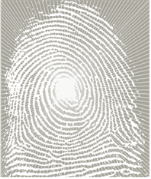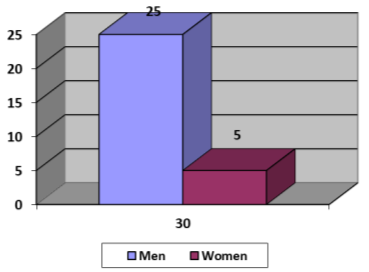Relevance: the Primary challenges posed by the investigating authorities to forensic medical examination is the identification of the person. In this regard, naturally increased interest in the use of affordable and effective research methods. One of the most convenient to study the «complex appearance» has become dermatoglyphics [1,2,3].
For over a century, dermatoglyphics remains an informative source and subject of studies in forensic science. So, in the works of a number of authors consider the questions of diagnostics of features of a person's fingerprints [4,5].
Published large number of papers on various aspects of dermatoglyphics, the data of which, in varying degrees, can be used for detection and investigation of crimes [2].
The genetic disease of papillary lines of the skin relief also allows you to try on the dermatoglyphics in medicine and anthropology [3]. With regard to the use of the characteristics of dermatoglyphics in medicine, it is primarily associated with clinical and sports medicine [5].
In the practice of forensic medicine and criminology dermatoglyphics, until recently, was used in the examination of disputed paternity, when the fingerprint identification and characterization of the individual papillary patterns — the establishment of gender, height, age [4].
The purpose of the study: to Study the constitutional, physical and externally-identification of factors on the basis of phenotypology finger and Palmar dermatoglyphics.
Research materials: 30 unidentified corpses in Republican Bureau of forensic medical examination and 50 students in TashPMI.
Research methods: we have Developed blind-stamped method provided us with the opportunity of obtaining in the next phase of prints of volunteers (ie living persons). To conduct a paint-free method, we used an ordinary scanner “EPSON perfection — 200”, with quality at 600 dpi in bmp format.
Results of the research: The obtained images were entered into the computer and automatically attached to the corresponding cells in the database. These images were in colour, so, after binding, they were transferred to black-and-white format. Most authors using dermatoglyphic method that relied only on account of the ridge from the center to the Delta. In connection with the problems arising in calculations of ridge papillaris fingers, we conducted research based on the developed software product «Analysis of ridge hand, finger and plantar papillaris method of Iskandarov — Kuziev». Based on the fact that, in most cases, the number of ridges can be the same in individuals of different sex and age, we have developed our own methodology. From the centre of papillary pattern to the periphery in a clockwise direction moves 240 rays. These rays form the 12 fields. In the path of rays are individual pieces of the pattern, such as bridges, Islands, branching and connections. This method allows rapid and efficient search through the database and compare the prints made as biometric and colorful methods. For the analysis of Palmar patterns there are four centers to three radii: a, b, c, d. From their centers to the periphery are sent to the rays, scanning all the features of the fingerprints (Fig. 1–4). The effect of this technique, scanning is the simultaneous scan of papillary patterns of fingers and palms, improving the quality of the source data, the contrast enhancement of different images of papillary drawings of fingers and palm, reducing system cost. Using this method is provided as pattern of skin lines due to the increasing sensitivity to the lines and reduced sensitivity to fat traces.
Analysis of the distribution of cadaveric material by gender gave the following results (Fig.5):
As can be seen from this diagram, we have analyzed the dermatoglyphic prints of the 30 corpses of persons of the Uzbek population, of which 25 (83,3 %) belonged to males and only 5 (16.7 %) are women.

Fig. 1. The scanned fingerprint

Fig. 2. It looks like the image is translated by software into black and white format

Fig. 3. E-the skeleton of the image.

Fig. 4. The ridge count of papillare with directed from the center rays
The study of the relationship of dermatoglyphic characteristics with anthropometric and crime was based mainly on the performance of males, due to the fact that the hormonal, physiological and morphological characteristics of the male body contribute to the relative stability of these characteristics and their anamo-morphological manifestations, which allows them to correspond to the model of human development.
The study of the relationship of dermatoglyphic characteristics with anthropometric and crime was based mainly on the performance of males, due to the fact that the hormonal, physiological and morphological characteristics of the male body contribute to the relative stability of these characteristics and their anamo-morphological manifestations, which allows them to correspond to the model of human development.
Special attention was paid to the investigation of dermatoglyphic characteristics. In the process of research developed the most convenient modification of the description of skin patterns of the pads of the distal phalanges. This following modification: And — arc patterns, which are divided into the following subtypes: A1 — tent of the arc A2 — loopylove of the arc A3 — lonesomedove arc, A4 — ones spindle arc.

Fig. 5. The distribution of cadaveric material by sex
The fundamental difference consists only in the fact that the lower point is not the first sloping line, and the Delta. The upper point is placed as in the arcs. Ridge score is calculated as the number of papillary lines crossing conditional vector, and the number of ridges, «trailer» to the line of the Delta coming up. The Delta in the calculation is not involved. The evaluation of these indicators is conducted by the tilt of the arc. If it is vertical, the counting is conducted with the ulnar side of the arc.
At this stage of the research revealed dermatoglyphic signs while interacting with gender. To identify the frequency of occurrence of types of patterns, in accordance with our modification of the description of skin patterns of the pads of the distal phalanges, depending on gender, were studied dermatoglyphic indicators of the finger, Palmar, and plantar prints from 30 of the corpses of persons of the Uzbek population. A preliminary analysis of the distribution of victims by sex showed that of the 30 bodies, 25 (83,5 %) belonged to males and only 5 (16,5 %) women (table.1). Analysis of the frequency of occurrence of types of patterns, depending on sex, gave the following results.
Table 1
The frequency of occurrence of types of patterns among victims of gender based
|
Pattern type |
right hand |
left hand | ||||||
|
Men (n=25) |
Women (n=5) |
Men (n=25) |
Women (n=5) | |||||
|
abs |
% |
abs |
% |
abs |
% |
abs |
% | |
|
A |
0 |
0 |
6 |
21,4* |
0 |
0 |
3 |
10,7* |
|
A1 |
0 |
0 |
3 |
10,7* |
0 |
0 |
3 |
10,7* |
|
A2 |
0 |
0 |
6 |
21,4* |
0 |
0 |
6 |
21,4* |
|
A3 |
0 |
0 |
3 |
10,7* |
0 |
0 |
0 |
0 |
|
A4 |
0 |
0 |
6 |
21,4* |
0 |
0 |
6 |
21,4* |
|
L3 |
15 |
10,6* |
0 |
0 |
32 |
22,5* |
0 |
0 |
|
LR |
125 |
88,0 |
9 |
32,1 |
125 |
88,0 |
6 |
21,4* |
|
LR1 |
15 |
10,6 |
16 |
57,1* |
15 |
10,6 |
9 |
32,1* |
|
LU |
47 |
33,1* |
0 |
0 |
32 |
22,5* |
0 |
0 |
|
LU2 |
15 |
10,6* |
0 |
0 |
0 |
0 |
0 |
0 |
|
WR3 |
63 |
44,4 |
9 |
32,1 |
0 |
0 |
3 |
10,7* |
|
WU4 |
0 |
0 |
0 |
0 |
32 |
22,5 |
9 |
32,1 |
|
W1 |
15 |
10,6 |
6 |
21,4 |
0 |
0 |
0 |
0 |
|
W2 |
79 |
55,6 |
3 |
10,7* |
47 |
33,1 |
3 |
10,7* |
|
W5 |
15 |
10,6 |
0 |
0 |
32 |
22,5 |
0 |
0 |
|
W6 |
0 |
0 |
6 |
21,4* |
0 |
0 |
3 |
10,7* |
Note: * — reliability of data according to sex
As can be seen from the data of this table, only the women on the distal phalanx and right and left hands most often encountered arc patterns (A) — 6 (21.4 %) on the right arm and 3 (10.7 %) on the left, the most common ones spindle arcs A2 (6 (21.4 %) on both arms) and single-loop arcs A4 (also 6 (21.4 %) on both hands), and loopback curls — W6 (6 (21.4 % on the right hand and 3 (10.7 %) on the left), in men these patterns did not occur.
Curved loop L3 , simple ulnar loops LU and two loop curls W5 met on the distal phalanges and the right and left hands in men (L3 — 15 (10,6 %) on the right hand and 32 (22,5 %) — on the left, LU — 47 (33.1 per cent) on the right hand and 32 (22,5 %) on the left, W5 — 15 (106 %) on the right hand and 32 (22,5 %) on the left), and Racecourse ulnar loop Lu2 was also found only in men but only on the distal phalanges of the right hand (15 (10,6 %)).
Thus, the results of the analysis of the frequency of occurrence of types of patterns depending on gender indicate that the presence of arc patterns, false-loop arches, one-loop arches and loopback curls in the examined imprints indicate that the imprints belong to the female, and the presence of curved loops, ulnar loops, two-loop curls and racquet-shaped ulnar loops indicate their belonging to the male person.
Conclusion: Thus, the analysis of modern scientific literature has shown that successful application of the method of dermatoglyphics in medical and forensic identification, along with other methods of identification, allows to speak about the system of methods effectively complement each other. Besides, insufficient development, practical need and morphogenetic nature (given the simplicity and non-invasive methods) determine the choice of finger (PD) and Palmar dermatoglyphics (LD) in the search of diagnostic criteria and markers of definitive manifestations in light of the overall integrity of the organism. The use of dermatoglyphic characteristics as the basic model of manifestation of constitutional, physical and externally identifying peculiarities determines the objectivity of scientific research.
References:
- Bonnevie K. Lassen sich die Papillarmuster der Fingerbeere fur Vater-schafts fragen praktisch verwerten //Zbl. Gynak., 1927., 9. 538.
- Zvyagin V. N., Tarasov I. B. Forensic aspects of dermatoglyphics of hands and feet //Court.-med. the expert. –M., 1989. — No. 2. — S. 14–17.
- Kolkutin V. V., Tomilin V. V., Bykov I. Y. Manual for the identification of unidentified victims in their mass arrival. -M., 2001.
- Nikolaev B. C, kildyushov E. M. On the division of expert institutions and funeral organization //Court.-med. the expert. — 2000. — No. 1.-S. 33–34/
- Sidorenko G. A., Mazur E. S., Zvyagin V. N. About medical and forensic classification ridge account the Palmar surface of the hands, based on the number of papillary lines relative to the main and additional triradius, loops and folds of the Palmar //Actual problems of theory and practice is judicial — medical examination. Collection of scientific works. Issue 3. Krasnoyarsk, 2005. — S. 139–140.

